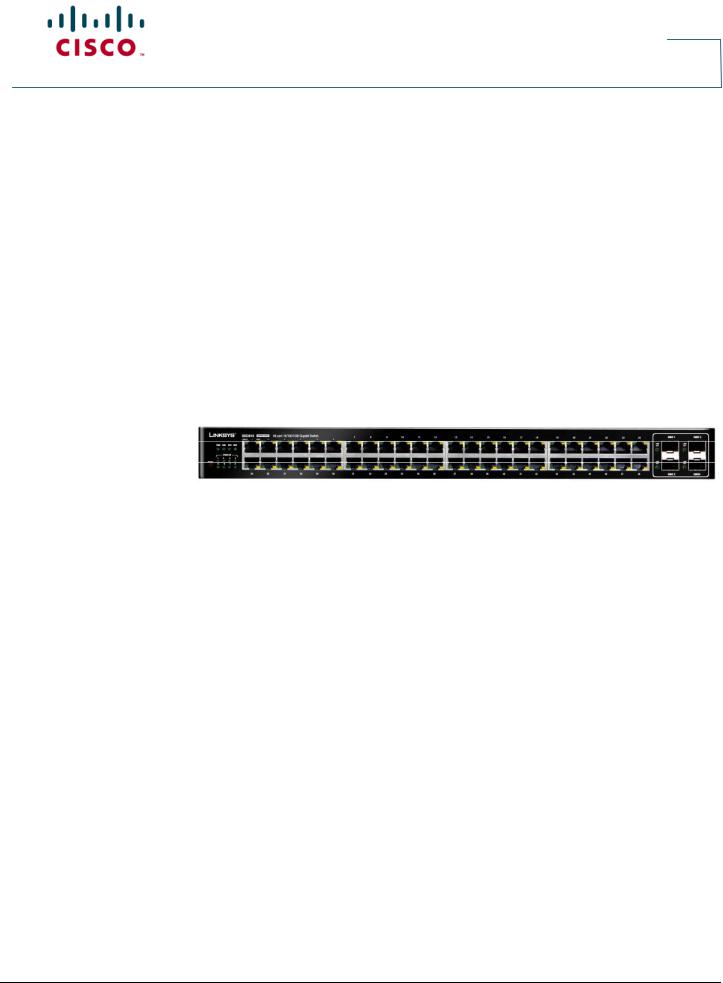cisco SGE2010 User Manual

Data Sheet
Cisco SGE2010 48-Port Gigabit Switch
Cisco Small Business Managed Switches
Performance and Reliability to Support Small Business Networks
Highlights
●48 high-speed ports optimized for the network core or to support bandwidth-intensive applications
●Resilient clustering provides the ability to manage several switches as a single switch to support growing businesses
●Advanced security protects network traffic to keep unauthorized users off the network
●Simplified, web-based management for easy installation and configuration
Figure 1. Cisco SGE2010 48-Port Gigabit Switch
Product Overview
The Cisco® SGE2010 48-Port Gigabit Switch (Figure 1) allows you to expand your network securely. Web-based configuration of the switch is secured using SSL.
The Cisco SGE2010 is optimized for maximum system availability, with fully redundant stacking, redundant power options, and dual images for resilient firmware upgrades. The switch helps secure the network through IEEE 802.1Q VLANs, IEEE 802.1X port authentication, access control lists (ACLs), denial-of-service DoS prevention, and MAC-based filtering. The enhanced quality of service (QoS) and traffic-management features help ensure clear and reliable voice and video communications.
The Cisco SGE2010 provides resilient stacking for up to four units, or 192 ports. A stack of units is managed as a single switch with one web management interface. The Cisco SGE2010 can coexist in a stack with the Cisco SGE2000 and SGE2000P 24-Port Gigabit Switches and the Cisco SGE2010P 48-Port Gigabit Switch, for a maximum of 192 ports in a stack. The stacking capability includes master/backup unit behavior, ring and chain architecture, and hot insertion and removal of units.
An intuitive, highly secure management interface provides access to the comprehensive feature set of the Cisco SGE2010, for a better-optimized, more secure network.
Features
●Forty-eight 10/100/1000 Ethernet ports
●Four mini Gigabit Interface Converter (mini-GBIC) slots (shared with four Ethernet ports) for fiber Gigabit Ethernet expansion
© 2008 Cisco Systems, Inc. All rights reserved. This document is Cisco Public Information. |
Page 1 of 5 |

Data Sheet
●Dual images for resilient firmware upgrades
●96-Gbps nonblocking, store-and-forward switching capacity
●Simplified QoS management using 802.1p, differentiated services (DiffServ), or type of service (ToS) traffic prioritization
●Power redundancy when used with the Cisco RPS1000 380W Redundant Power Supply Unit
●Fully resilient stacking provides optimized growth with simplified management
●ACLs for granular security and QoS implementation
●Configuration and monitoring from a standard web browser
●Secure remote management of the switch via Secure Shell (SSH) and SSL encryption
●802.1Q-based VLANs enable segmentation of networks for improved performance and security
●Private VLAN Edge (PVE) simplifies network isolation of guest connections or autonomous networks
●Automatic configuration of VLANs across multiple switches through Generic VLAN Registration Protocol (GVRP) and Generic Attribute Registration Protocol (GARP)
●User/network port-level security via 802.1X authentication and MAC-based filtering
●Increased bandwidth and added link redundancy with Link Aggregation Control Protocol (LACP)
●Enhanced rate-limiting capabilities, including back pressure and multicast, broadcast, and flood control
●Port mirroring for noninvasive monitoring of switch traffic
●Jumbo frame support up to 10 KB
●Simple Network Management Protocol (SNMP) versions 1, 2c, and 3 and Remote Monitoring (RMON) support
●Fully rack mountable using included rack-mounting hardware
Specifications
Table 1 contains the specifications, package contents, and minimum requirements for the Cisco SGE2010 48-Port Gigabit Switch
Table 1. |
Specifications for the Cisco SGE2010 48-Port Gigabit Switch |
|
|
|
|
Specifications |
|
|
|
|
|
Ports |
|
48 RJ-45 connectors for 10BASE-T/100BASE-TX/1000BASE-T with 4 Gigabit combo ports |
|
|
shared between mini-GBIC ports; console port; auto MDI/ MDI-X; auto negotiate/manual |
|
|
setting; RPS port for connecting to redundant power supply unit |
|
|
|
Buttons |
|
Reset button |
|
|
|
Cabling type |
|
Unshielded twisted pair (UTP) Category 5 or better for 10BASE-T/100BASE-TX; UTP |
|
|
Category 5 Ethernet or better for 1000BASE-T |
|
|
|
LEDs |
|
PWR, Fan, Link/Act, PoE, Speed, RPS, Master, Stack ID 1 through 8 |
|
|
|
Performance |
|
|
|
|
|
Switching capacity |
96 Gbps nonblocking |
|
|
|
|
Forwarding capacity |
71.4 mpps (64-byte packets) |
|
|
|
|
Stacking |
|
|
|
|
|
© 2008 Cisco Systems, Inc. All rights reserved. This document is Cisco Public Information. |
Page 2 of 5 |
